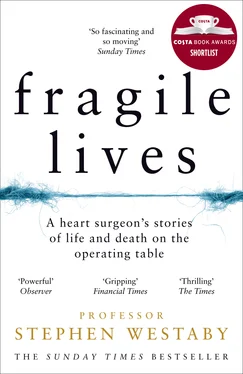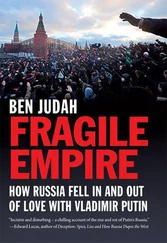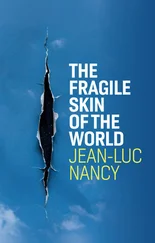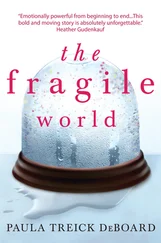Sleep deprivation underpins the psychopathy of the surgical mind – immunity to stress, an ability to take risks, the loss of empathy. Bit by bit I was joining that exclusive club.
4
Genius is one per cent inspiration, ninety-nine per cent perspiration.
Thomas Edison
October 1979. I was Senior Registrar with the thoracic surgery team at Harefield Hospital in north London. Everyone training in heart surgery had to learn to operate on the lungs and gullet as well, and this meant working with cancer, which I found deeply depressing. Too often it had already spread to other parts of the body, and for most patients the prognosis was grim, so they were depressed too. Moreover, there was an element of monotony about it. The choices were stark: between taking out half a lung or the whole lung, on the right or on the left, or removing the upper part of the gullet or the lower half. After doing each one of these procedures a hundred times it was no longer very stimulating.
Every so often a more challenging case would present itself. Mario was a forty-two-year-old Italian engineer working on a restoration project in Saudi Arabia. A jovial family man, he’d gone to the kingdom hoping to earn enough money to buy a house, which meant toiling hours on end at a large industrial complex outside Jeddah in the searing desert heat. Then catastrophe. Without warning, while he was working in an enclosed area, a huge boiler exploded, filling the air with steam. Steam under high pressure. It scalded his face and burnt the lining of his windpipe and bronchial tubes.
The shock almost killed him immediately. The scalded tissues were dead and whole sheets of necrotic membrane sloughed off from the lining of his bronchial tubes. This obstructive debris had to be removed through an old-fashioned rigid bronchoscope, a long brass tube with a light on its end passed through the back of his throat and voice box then down into his airways.
Mario needed this done regularly, almost daily, to prevent asphyxiation, and pushing the bronchoscope back and forth through his larynx became more and more difficult. Soon it became so scarred that the bronchoscope would not pass and he needed a tracheostomy – a surgical hole in the neck to enable him to breathe. But the dead bronchial lining was quickly replaced by inflammatory tissue and masses of cells started to fill the airways like calcium blocking water pipes. He became unable to breathe, and his condition took a relentless downhill course.
I took the call from Jeddah. The burns doctor looking after him explained the dire situation and wondered whether we had any advice. My only suggestion was that they airlift him to Heathrow and we’d see if anything could be done, so the building company paid for the medical evacuation and he arrived the following day. At the time my boss was in the twilight of his career and was happy for me to take on as much as I felt confident to do. Which was everything. I had no fear. But this was a disaster in a middle-aged man. I asked that we should take a look down his windpipe together and then try to come up with a plan.
Mario was a sorry sight. He was gasping for breath, with the infected froth pouring from his tracheostomy tube making a dreadful, gurgling sound. His scarlet face was badly burnt, its crusted, dead skin peeling away and weeping serum. Burnt on the outside and burnt on the inside, the fragile and bloody tissue that occluded the whole of his windpipe was going to asphyxiate him. It was a great relief for him to be put to sleep.
As he lapsed into unconsciousness I sucked blood-stained sticky secretions from the hole in his neck, then attached the tubing from the ventilator to the tracheostomy tube and squeezed the black rubber bag. The lungs were difficult to inflate against the resistance. I decided that we should attempt to pass the rigid bronchoscope by the normal route directly through the vocal cords and larynx. This is akin to sword swallowing, but down the airways rather than the gullet.
We needed a view of the whole windpipe and both right and left main bronchial tubes. For this the head needs to be tipped at the correct angle so the vocal cords at the back of the throat can be seen. We do try hard not to knock out any teeth. This technique used to be performed on conscious individuals after lung surgery, when I’d have to hoover the patients out because there were never enough physiotherapists. Rough at the time but better than drowning.
I manoeuvred the rigid telescope over the teeth and along the back of the tongue, then peered down to locate the snippet of cartilage – the epiglottis – that protects the opening of the voice box during swallowing. If you lift its tip with the bronchoscope you should be able to find the glistening white vocal cords, with a vertical slit between the two. This is the way into the windpipe and I’d done the procedure hundreds of times to biopsy lung cancer. Or remove peanuts. But here, with the voice box burned and the vocal cords like sausages, inflamed and angry looking, there was no way through. Mario was entirely reliant on the tracheostomy.
Standing aside, I tried to show the boss by keeping the bronchoscope still, propped on the teeth. He grunted and shook his head. ‘Try pushing it harder. Nothing to lose, I suspect.’
Taking aim again, I pushed the beak of the scope where the slit should be and shoved. The swollen vocal cords parted and the instrument crashed against the tracheostomy tube. We attached the ventilating apparatus to the side of the bronchoscope and pulled out the tube. Normally we’d see the full length of the windpipe to where it divides into the main bronchi. In this case, not a chance. The airways had been virtually obliterated by the proliferating cells, so I eased the rigid implement onward using the sucker to aspirate blood and detached tissue, at the same time pushing in oxygen through the bronchoscope tip. I was hoping to see an end to the burns, and we finally encountered normal airway lining halfway down each main bronchial tube. But now the traumatised lining was oozing blood.
Mario’s bright red face had turned purple and was getting bluer by the minute, so the boss took over, peering down the tube, occasionally inserting the long telescope for a better view. It was a precarious situation without an obvious solution. If you can’t breathe you die. Fortunately with time the bleeding died down and the airway was better than it had been once some gunk had been removed. We reinserted the tracheostomy tube and put him back on the ventilator. Both sides of the chest still moved and both lungs were inflated. This was a triumph in itself, but it was doubtful there was any way forward. We both concluded that his prospects were bleak.
Two days later Mario’s left lung collapsed and we went through the same process again. It was just as bad. The tissue just kept on growing, and he remained fully conscious on the ventilator but very distressed.
Asphyxiation is the most miserable way to die. I remembered my grandmother, strangulated by cancer of the thyroid gland. She’d been told she needed a tracheostomy, only to have the procedure aborted, so she sat propped up in bed day and night gasping for breath. I recalled trying to work out ways to help. Why wasn’t it possible to put a tube further down, past the obstruction? Why couldn’t tracheostomy tubes be made longer? A simple concept but I was repeatedly told it wasn’t possible.
From what I could see through the bronchoscope, the situation with Mario was nearly identical. He needed something to bypass his whole trachea and both main bronchi, otherwise he’d be dead in days. We couldn’t keep opening the airways with a bronchoscope. Not forever. Grim Reaper was winning this battle and was about to swing his scythe.
Читать дальше












